July 12th, 2009

Image*After and MorgueFile are Web resources where you can find and download high resolution photos for use in PowerPoint presentations or Web pages. MorgueFile’s name comes from the archives kept by newspapers and the Police of old photographs. You can used the ‘advanced’ search page in Flickr and specify only images with a Creative Commons licence.
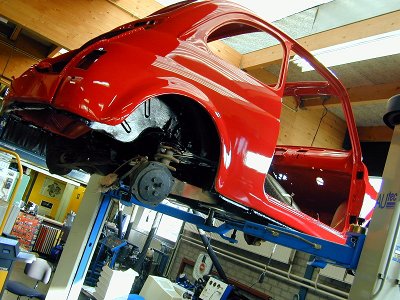
Remember Seth Godin’s Really Bad PowerPoint e-book?
“You put up a slide. It triggers an emotional reaction in the audience. They sit up and want to know what you’re going to say that fits in with that image. Then, if you do it right, every time they think of what you said, they’ll see the image (and vice versa).1”
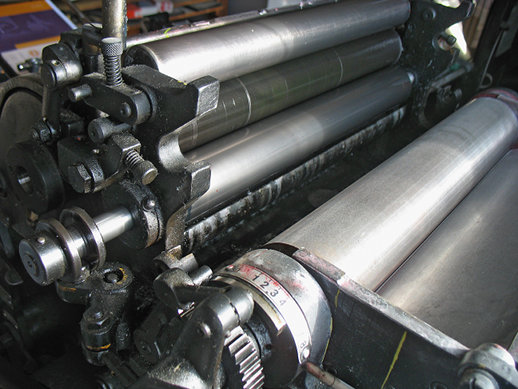
I’d use the image above if I was doing a presentation about how newspapers are failing to react to the Web and the new advertising models. The old press with swarf on the cogs and dull metal rollers conjures up the smell of the presses (I used to walk past the Liverpool Echo presses most days 30 years ago) and conveys the oldness of the medium. I’d need other images to show what is being lost as the newspapers drain money and eyeballs.
Posted in ILT, Photos | Tags: copyright free, images, Photos | Comments Off
July 12th, 2009
“... why am I completely incapable of putting non-verbal marks on a page so they do the same? What neural channels are so blocked that my ducks don’t just look wonky, they look like scribbles? Why does eye-mind-hand work about as well in me as I contemplate a teacup or imagine a tree, as it does in my two-year-old nephew?”
and
“This must be what a lot of real beginner-writers feel. There’s stuff in their head or before their eyes which they yearn/burn to get down on paper. And when they try? It reads like scribbling. Awkward, ugly, incompetent, even incomprehensible. The one writerly skill I’ve always had is the capacity to bend words to my purpose (I just had to learn everything else about writing fiction). So I’ve never really had the feeling that the words in my hands won’t do what my mind wants them to. Now by analogy I know how it feels, and as a teacher that’s a lesson worth its weight in red biros.”.Emma Darwin, It doesn’t matter
All teachers should have something they do that ‘doesn’t matter’ and that they have to learn from scratch. That’s me and my piano, Darwin and her drawing. Then we can understand students better. What’s your thing that does not matter?
Posted in Learning | Tags: beginners mind, craft, Learning | Comments Off
July 11th, 2009
Two articles from The Atlantic
Both reference Proust and the Squid by Maryanne Wolf.
Posted in Learning, a red herring | Tags: brain science, Learning | Comments Off
July 9th, 2009
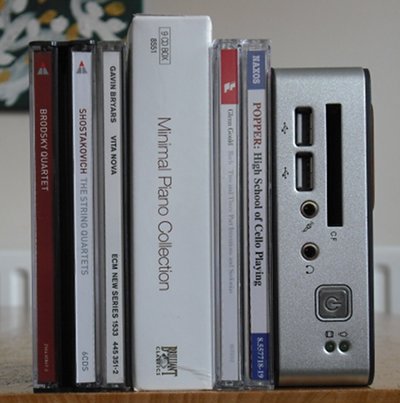
Computers should be like toasters, they should just work for years and then when they stop working, you should be able to pop out and buy a new one. Toasters don’t need backups, and a major cause of problems with computers is loosing data (which may include family pictures and purchased music as well as College work).
Google’s Chrome OS looks like it might be a solution to both failing PCs and the need to back up data. It will be the second branded operating system built on top of an open source kernel and tool chain. Mac OS ‘just works’ and looks nice, has full desktop functionality, local storage and a huge range of software. By contrast (BBC report, Google) Chrome OS may not be able to run applications that require an API richer than the browser. The obvious questions that spring to mind include “Where do I keep my music/photos/videos?” and “What happens if my Internet connection fails?” and “How do I install real programs?”. Local storage with cheap online backup could be a very popular combination. The gOS operating system had direct links to Google Apps integrated into a nice desktop, but used local storage and had OpenOffice installed.
Google mention working with hardware manufacturers. My toaster PC in the photo above is the Aleutia E2, a low power fanless PC that has enough processing power to view Web pages, do e-mail, write Maths worksheets and presentations, but does not quite make it through a YouTube video. That runs Debian Squeeze, but there is a spare partition, and I’ll be trying the Chrome OS when it arrives in public beta form.
The Google blog carries an interesting post written just after the Chrome OS announcement that describes SMS based access to Google services in Uganda. The mobile phone may be a mass platform in many countries.
Added 11th July: A Daringfireball article has some ideas and links about Chrome OS. I think this article makes valid points. Disclaimer: I use Ubuntu and therefore according to Gruber I’m not a real person. Help, I’m fading away!
Posted in ILT, Notes | Tags: operating systems, platforms | Comments Off
July 7th, 2009
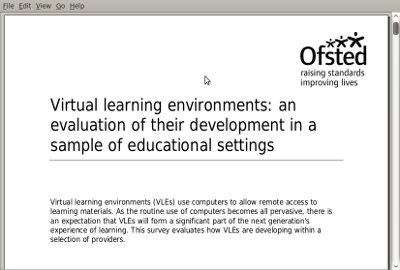
Virtual learning environments: an evaluation of their development in a sample of educational settings is a report from OFSTED that looked at 18 college VLEs, with ‘reviews’ of 5 more.
“We found that the exploitation of VLEs at curriculum level resembled more of a cottage industry than a national technological revolution.”
Of course, if you want a ‘national technological revolution’ then you need to provide some resources… The authors have made some important points about the quality of materials found on VLEs, and the lack of interactive use of VLEs in the sample of Colleges (and other institutions) surveyed.
“The best VLEs reviewed allowed learners to reinforce their routine work, or catch up on missed lessons. In those best cases the material offered was fun and helpful and was being used well by learners. In the least effective examples, documents had been dumped on the system and forgotten.”
and I found the following paragraph especially revealing
“It was assumed that [ forums ] might be a popular aspect of a VLE given the prolific use of such sites, including social networking sites, among young people. The survey identified one forum in a high-achieving senior school, and three very specific projects with other providers which, in two instances, were aimed at older learners on level 3 and 4 courses.†-para 33
That assumption is commonly made, but effective educational use of forums is harder than might be imagined to develop with any group of students of any age. “Build it and they will come” is a slogan that might work in the development of open source software, but not in teaching and learning. As Diana Laurillard put it in the interview cited in another red herring.
“I mean, we had ubiquitous technology and all the communication technologies decades ago and it hasn’t really transformed higher education. So I think that shows you that the access issue, that we will just make the technology available and everything else follows, is false, that’s a fallacy. It’s got to be a different way of thinking about what teaching and learning means and how technology can support that” -Laurillard / Donovan interview, 2006
The OFSTED report is important, and needs to be widely read. I think we are well on the way from ‘cottage industry’ to ‘universal service’ in my College, but we do need to do more work on effective educational use of forums. The report raises (among many other managerial aspects) the issue of quality standards for VLE materials, and the (anonymous) authors report that:
“No provider in the survey had a formal quality assurance system that ensured material on their VLE was routinely reviewed to ensure it was up to date, relevant, accurate or appropriate. Three providers had numerical targets for populating their VLE with course material which were then reviewed, but they did not have qualitative reviews. The lack of a quality assurance system was not seen as a significant concern by the providers. The reasons for not having a formal quality assurance system included the belief that the VLE was effectively an extension of a lesson, and as such it was the responsibility of the relevant tutor to maintain standards as they would with lesson material, with appropriate oversight from heads of department. There was also a concern, as with imposing a common structure, that at this early stage of development of the VLEs, too many restrictions would dampen the enthusiasm of those who were taking a lead. A formal system might also discourage others whose material was, as yet, not reviewed frequently in the classroom.” -paragraph 51
My question now is: can we scaffold the development of courses in Moodle without using a blunt instrument like a quality standard?
Posted in ILT, a red herring | Tags: policy | Comments Off
July 5th, 2009
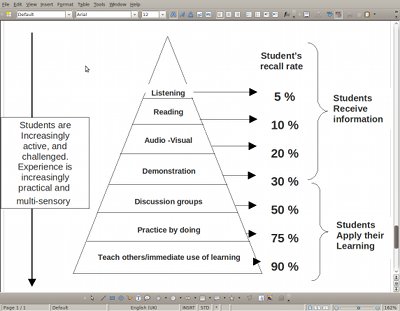
The crux of the problem. Active learning is known to be more effective than receiving information, but we don’t use the active tools in Moodle. Geoff Petty gives out a large number of handouts on the downloads page of his Web site. The pyramid above was found in the Word file called Active Learning Works, which is the first download on the page.
Posted in ILT, Learning, a red herring | Tags: elearning, Learning, Teaching | Comments Off
July 5th, 2009
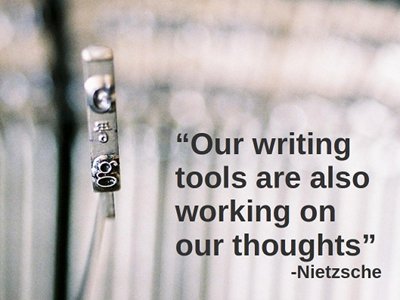
This Red Herring post is about the images used in the Stance section of the presentation. I have strong views on PowerPoint, and prefer to use mainly images with a few words and diagrams.
Nietzsche was fond of his schreibkugel. The Friedrich Nietzsche quote is taken from Friedrich Kittler’s book Gramophone, Film, Typewriter, Standford University Press, 1999, translated by Geoffrey Winthrop-Young and Michael Wutz. The book deals with these three technologies that put a mechanical layer between ourselves and the performance or text, and that allowed reproduction of performances. Just one irony: before the gramophone became a mass technology, many households had a piano. Young ladies were encouraged to take lessons and to play light music in the home – and not just in richer families. As Kittler documents, this pool of young women trained to use all their fingers enabled the rapid adoption of writing machines. The gramophone began to replace the piano in the next generation. As Seb Schmoller has pointed out in a nice diagram, we are at the very beginning of another technological change, and similar ironies can be expected.
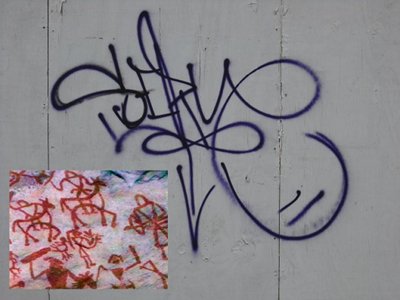
The last ten years has seen a significant increase in knowledge in how the brain learns to read. These developments are summarised in popular and accessible form in Maryanne Wolf’s Proust and the Squid: The Story and Science of the Reading Brain, published by Icon Books in the UK. Pages 145 to 154 explain the processes and circuits used when we fixate on a word between saccades (around 250 milliseconds). The small image of a cave painting in the Bhimbetka rock shelters was taken by Sarbanidas Roy. The ‘tag’ image is my own.

Our new writing tools. I rendered the outside of the poster as a greyscale to underline the way some people find the online world more engaging than “R.L.” (‘real life’). As one of Sherry Turkle’s students put it some years ago, “RL is just one more window, and it’s usually not my best one“.
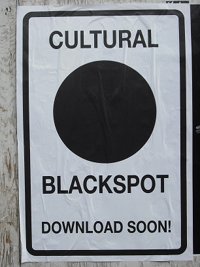
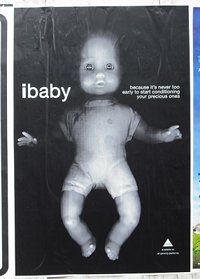
East Side in Digbeth is undergoing significant development at present. These two artist posters appeared on a building fence site. The iBaby image is very simple: it is a scan of an old doll. When you scan a three dimensional image, only the parts of the object in contact with the scanner bed will be in sharp focus, there will be a very fast loss of focus and illumination as you move away from the scanner bed.
Posted in a red herring | Tags: images, Learning | Comments Off










